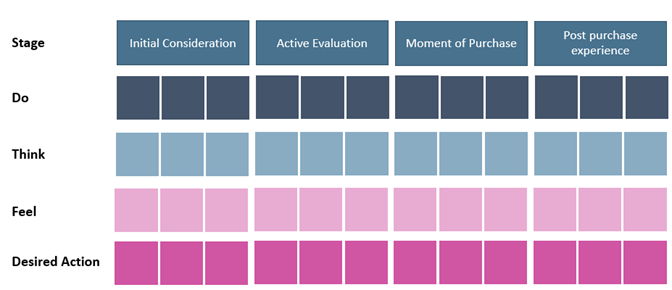Customer Journey – Thinking from the Point of View of your Customer
As opposed to imposing upon customers with calls to action with no real regard for where they are in the decision-making process, consider shifting to a customer-centric point of view. As a result, customers will be more likely to stay engaged with your brand through a purchase, and remain loyal.
The first mistake many business owners and operators make is thinking about how they themselves would like to be marketed to. For example, by saying, “I don’t open and read promotional emails, so we don’t do email”, you have automatically taken your customer out of consideration for your marketing and advertising efforts and are only thinking about you. And without customers, what do you have left?
By defining a customer journey and tailoring communications around that journey, your communications will begin to be supported by experiences and stages individuals may make along their journey to a purchase.
What is a Customer Journey?
A customer journey is simply a definition of specific experiences or longer stages a customer may have as they interface with your business in relation to their life. Basic formatting for a customer journey uses visualizations – either in either a simple linear or cyclical journey or advanced illustrated road map with twists and turns along the way. Depending on the purpose of defining a journey, a customer journey may entail a long detail-ridden journey with many micro-moments or, the journey maybe defined by a couple key moments or broad stages.
Diagram A: Simplified, linear representation of the McKinsey decision-making process.

McKinsey’s research further defines, the number of brands consumers consider during each phase of the consumer journey varies depending on the industry. This is an important insight for brands to remember when mapping their own customer journey.
What are your customers feeling, thinking, or doing? When?
Sidenote: This blog is not a millennial’s attempt for you to feel empathetic to everyone’s individual feelings and make personal accommodations. Not exactly.
Once the experiences or stages of your customer’s journey has been defined an added layer to understand what customers are doing, thinking, and/or feeling help marketers generate actionable insights for messaging and marketing channels.
Diagram B: Laying on insights for what customers are doing, thinking, and feeling under McKinsey’s decision-making process.

What do you want your customers to do?
With any marketing communication, we define the call to action, CTA. What do we want customers to do as a result of seeing, reading, reviewing an advertising “artifact?” Once a user reaches the bottom of a webpage, they are likely greeted with a logical next step: buy now, read more, call today. In pharmaceutical commercials the narrator inevitably says, “Ask your doctor about (insert drug) and the intended use and side effects”. Its important to guide the customer to your desired action. More importantly, we want to give the right direction.
Example: For a car purchase, it would be brazen for a manufacturer to include a “buy now” button based on a single view of a car model within a website. Instead, website visitors typically guided to use online customization tools, find local dealers, or compare similar models. By asking a customer for an upfront purchase while they are doing preliminary research in the initial consideration phase of their customer journey may risk turning off the customer and losing them completely. Common support the previous assumption but documenting a customer journey by conducting research and generating actionable insights from customer interviews, surveys or website analytics eliminates guess work.
Diagram C: Desired Action defines actionable insights for marketing communications after defining customer journey, using the McKinsey decision making process, and laying on doing, thinking and feeling.

Additional Actionable insights within the Customer Journey
Organizations who frequently place emphasis on understanding their customers may find additional nuggets of information which support putting the correct message in front of those customers at the right time. As opposed to being part of the primary customer journey, these are moments in time that allow us to understand what customers are doing, thinking, or feeling within a specific stage of the customer journey.
Delightful Moments
Moments when customers experience joy allow an understanding when an additional communication may take place. Right after someone makes a major purchase, they may be willing to provide a review. An automated email and or text message asking for insights on the experience or leave a review rating is timely.
Painful Moments
In any customer journey, there may be painful moments customers experience. During these times, messages of empathy or reassurance may help move individuals to the next phase of their journey.
Moments of Truth
Whether good or bad, there maybe he ah-ha moments discovered during the customer journey with an actionable insight. How do you discover these moments of truth?
- A|B Testing – Testing between tactic such as email or SMS message or messaging in order to determine what your customers best respond to
- Surveys – Instead of leaving surveys for a post-purchase follow-up, survey customers along their journey to gain valuable insights
- Moderate customer-owned touchpoints – Read reviews and social media content to determine if customers are experiencing the same feelings at specific points in their customer journeys
Sample delightful moment and call to action: On a blistering 115-degree day, customer’s air conditioner begins to blow hot air. Using his premium membership, he calls his A/C service and requests a same day appointment. Following his service appointment and happy with the cool air now circulating his home, the customer receives a text message asking for a review of the technician’s performance. The feedback is shared directly through the customers phone and is received by the owners of the A/C company. By requesting the review while the customer was still experiencing their ‘Moment of Delight’, provides a higher likelihood they will receive a response.
Conclusion
Crawl. Walk. Run. If you are not currently using a customer journey to shape your marketing and advertising, the due diligence of truly understanding your customer’s can take time. A great place to start is with each and every collateral being developed to stop and ask. When would a customer see this? What are they thinking, feeling or doing when they see the material? And what do you want them to do upon seeing it? The answer will not be to always close a sale. Many times, you may be supporting research by asking them to learn more or compare options. Or, you may want people to initiate a call/form to start a conversation with a sales team member. Taking a step back and starting to acknowledge the customers role in digesting branded content, will begin to ensure you are asking your customers to do the right thing. At the right time.
